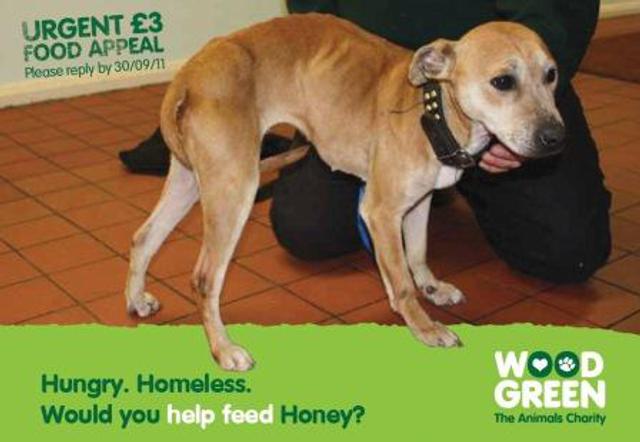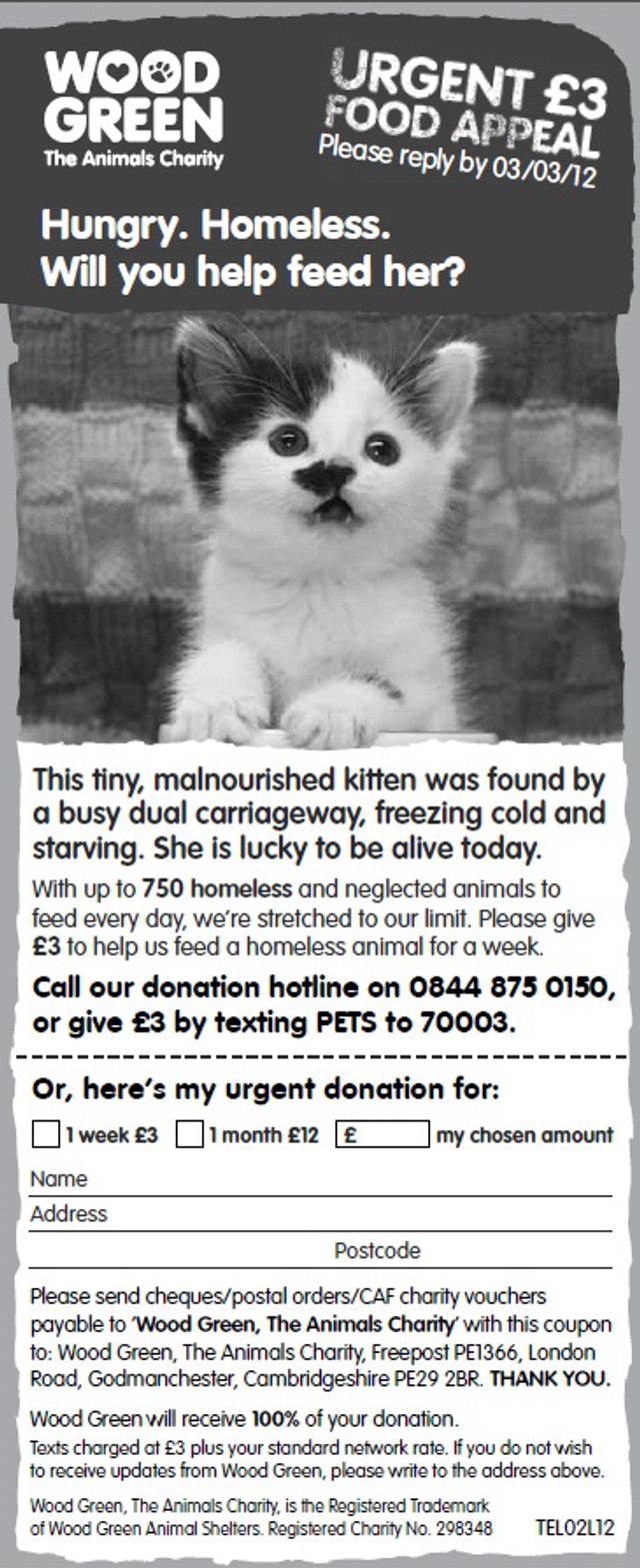Wood Green Animal Shelters: urgent £3 food appeal
- Exhibited by
- SOFII
- Added
- May 24, 2012
- Medium of Communication
- Direct mail, press advertising
- Target Audience
- Individuals, single gift
- Type of Charity
- Environmental/animals
- Country of Origin
- UK
- Date of first appearance
- September, 2011
SOFII’s view
Even though animals, particularly sweet kittens, are considered to be an easy way to raise money it is a very crowded market and Wood Green, The Animals Charity had to develop a strategy to recruit new supporters with a low value gift. Interestingly they went back to more traditional methods: press advertising and direct mail. However, they also combined these with more modern techniques, such as SMS. Adding considerable testing they have achieved some great results.
Our direct marketing agency, Dovetail Direct Marketing Support Ltd, developed the concept for the campaign and managed the creative and media planning. One member of Wood Green staff managed the campaign in-house.
Name of exhibitor
Rosie Blanning, donor development officer, Wood Green, The Animals Charity.
The objectives of the ‘urgent £3 food appeal’ were as follows:
- To recruit new cash donors.
- To generate income to help with the cost of the animals’ food.
- To reactivate lapsed cash supporters
Background
Wood Green, The Animals Charity had found it tougher to recruit new cash supporters in 2010 and the beginning of 2011. As a local charity that had just re-branded and was fundraising in a heavily saturated market place, the donor development team knew that they needed a new strategy for recruiting and retaining supporters. Wood Green worked with their creative agency, Dovetail Direct Marketing Support, to come up with a new campaign to recruit new supporters with a low value gift. They wanted to show that even a small gift could make a big difference. The main fundraising channels for this campaign so far have been direct mail and press advertising. Wood Green wanted to go back to using the more traditional methods of fundraising – such as a coin holder in the direct mail pack and a press advert with an urgent, emotive story – but still using more modern techniques alongside these, such as an SMS response on the press adverts and an outbound SMS campaign.
Special characteristics
We used a case study that had provoked a very emotive response when we first told our supporters about it using an online appeal earlier in the year – Honey the dog. She had been abandoned outside our London centre and had made headlines due to the fact that she was extremely underweight, but also because we had CCTV footage of the person tying her up outside the centre. The picture used on the outer of the mail pack and one of the press advert variations shows Honey when she first arrived. Her body language speaks volumes to any animal lover – she looks terribly thin, her tail is between her legs and her eyes look incredibly sad. The letter copy also directs readers to our website where they can watch the CCTV footage for themselves.
We also included a case study of a cat as the majority of our supporters prefer cats to dogs so we wanted to appeal to both cat and dog lovers. The kitten that we used had attracted a great deal of press coverage at the time of the campaign.
We also put a lot of thought in to the coin card donation device. Our creative agency tested posting different devices to see if the coins became dislodged, or could be easily felt from the outer envelope, which could encourage stealing. On our device the flap folds over the coins which helps to keep them in place but also makes them less recognisable when put inside the return envelope. The donation device also gives a very visual donation experience – the donors could choose whether they wanted their coins to buy an animal’s breakfast, lunch, or dinner – and they could also give an extra £1 to buy treats. A reply-by date was also used throughout the pack to highlight the urgency of the appeal.
Influence/impact
So far we have mailed the DM pack twice and have run eight press adverts. The results so far are:
- 6,152 new donors recruited (116 per cent more than target).
- 635 lapsed donors reactivated (69 per cent more than target).
- £51,727 raised (78 per cent more than target).
- Achieved an overall ROI of 0.72 before the end of year one.
We have been so pleased with the results of this appeal that we will now be using it as our control creative. We will now be using low value giving as our main channel of cold cash recruitment. We have learned that despite asking for a low amount, the volume of supporters recruited still means that we raise a higher income and achieve a better ROI than if we had recruited fewer donors at a higher amount. As it doesn’t look as if the the economic climate is going to improve any time soon we believe this will be a much more achievable and sustainable method of fundraising for us. The supporters that we have recruited through the urgent food appeal are responding well to our warm appeals programme and we are already seeing a positive long-term value from them.
Details
The first outing of the urgent food appeal was a test. We mailed 50,000 cold names of which 3,795 were obtained from a swap with another charity – this was also a test as we had never done this before. We tested 10 new cold lists with the first mailing of the appeal and tested a further reciprocal list with the second mailing in February 2012. This was also the first time we had tested SMS as a response method on press adverts. This proved to be really successful with a third of donations to the press adverts made by SMS.
Merits
We think that at a time when donors are giving all they can and when so many charities are asking them for help it is important to show how even just a small amount can go such a long way. We were apprehensive at first and thought that using this type of recruitment would mean that we would be aiming for volume over value – but we have been proved wrong. We are now achieving better ROIs on our cold recruitment campaigns than ever before.



















